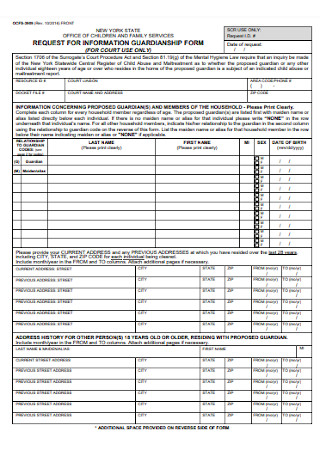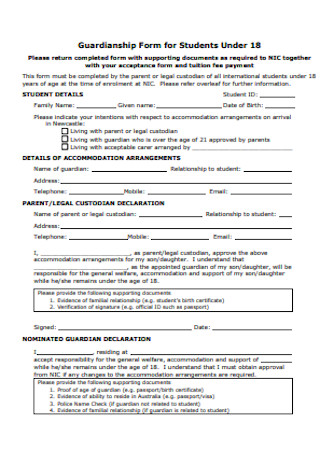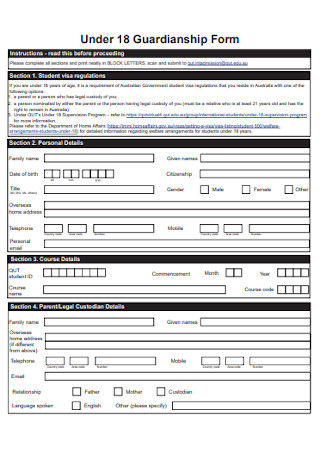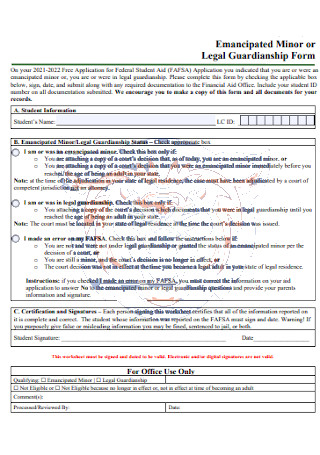25+ Sample Guardianship Forms
-

Parental Consent Guardianship Form
download now -

Standby Guardianship Form
download now -

Temporary Guardianship Form
download now -

Request for Information Guardianship Form
download now -

Guardian Declaration Form
download now -

Education Guardianship Form
download now -

Child Guardian Consent Form
download now -

Guardianship Form for Minor
download now -

Pet Guardianship Form
download now -

Individual and Guardian Information Form
download now -

Guardianship Form for Students
download now -

Guardianship Form Format
download now -

Under 18 Guardianship Form
download now -

Request to Nominate Guardian Form
download now -

Legal Guardianship Consent Form
download now -

Student Guardianship Form
download now -

Guardian Advocacy Forms
download now -

Guardianship Verifivation Form
download now -

Gurdian for Minor Child Form
download now -

Legal Guardianship Form
download now -

Guardianship Information Form
download now -

Guardianship Intake Form
download now -

Guardianship of Minor Information Form
download now -

Declaration of Parentage Guardianship Form
download now -

Designation of Standby Guardian Form
download now -

Guardian Inventory Form Template
download now
FREE Guardianship Form s to Download
25+ Sample Guardianship Forms
What Is a Guardianship Form?
Brief History of Guardianship
Types of Guardianship
Parts of a Guardianship Form
How to Create a Guardianship Form
FAQs
What paperwork is needed for legal guardianship?
What does guardianship entail?
Can a guardianship be revoked?
Why is guardianship necessary?
What is the difference between guardianship and conservatorship?
Who determines guardianship?
What Is a Guardianship Form?
A guardianship form is an official document declaring a person’s legal right to care for another person or property. It states that the ward, or the person who is under the care of the guardian, is entitled to receive support and care by the legal guardian.
According to the American Geriatrics Society’s Health in Aging Foundation, there are two types of guardianships. The first one is known as a limited guardianship, or also sometimes called conservatorship, which allows the legal guardian authority over a specific area that the ward is unable to manage. This normally includes finances and health care. The second type is an unlimited guardianship, also called a committeeship. This kind of guardianship strips the ward of any legal authority and gives the guardian the power to make all major decisions on behalf of the ward. These decisions include medical care, property, assets, personal relationships, and residence. However, many states favor limited guardianships over unlimited guardianships because the latter demands that the court finds that the person is legally incapacitated and incompetent. In order to assume unlimited guardianship, it would need to be established in court that the person be deemed as totally incapable of all types of decision making.
Brief History of Guardianship
It takes a village to raise a child. This proverb cannot be more accurate. According to the National Center for Child Welfare Excellence, the idea of guardianship dates as far back as the early Roman Empire. The parents of a child possessed the natural right and responsibility over the child. Further, extended members of the family were also expected to support other members, including children. During the European Middle Ages, English common law designated the father as a child’s legal guardian. Upon the father’s death, the child would be turned over to the mother. Or in some cases where the mother owned no property, sometimes the feudal or land lord was made the guardian. The courts in feudal times had vested interests in the child, including the land and property that the child possibly inherited. Thus, the courts would normally step in and appoint suitable guardians.
Types of Guardianship
Typically, a guardian is closest kin or a trusted relative. But there are some cases wherein a guardian is appointed by the state or court. The following are the basic types of guardianships:
Parts of a Guardianship Form
There several basic parts of a guardianship form. Although it may hold multiple versions and differ in format, they all essentially contain the same main points, which include the following:
How to Create a Guardianship Form
There are a number of editable templates for you to use. It’s fairly easy to create a guardianship form if you have a standard guide to follow. As long as you prepare the necessary information, you don’t need to worry about starting from scratch. Standard legal guardianship forms are usually straightforward. Just keep in mind these simple steps:
Step 1: Decide On a Format
Although forms may vary from county to county, many government agencies have standard forms that only require the petitioner to fill it up and attach the necessary supporting documents. A guardianship document can also come in the form of a letter. These are for instances wherein a parent is officially handing over temporary responsibility to a court appointed guardian.
Step 2: Fill In the Necessary Details
Make sure you provide complete information of both the ward and guardian. Include the complete name, complete address, and contact information. Indicate the guardian’s relationship with the ward. Specify the type of support and care needed. If, for example, the minor requires special medical or emotional treatment, it is best to disclose and enumerate these needs. Or if the mentally handicapped adult is undergoing regular therapy sessions, you may need to indicate these details in your form as well.
Step 3: Include a Declaration Statement
Some guardianship forms contain an oath declaring that all the facts stated are true. It reinforces the guardian’s duty of providing care and support to the ward; for the length of time as stipulated in the document. Some courts issue only temporary guardianship over a ward. While others, such as in the case of estate guardianship, may last longer.
Step 4: Attach Any Supporting Documents
This is optional, but sometimes authorities require other substantial documents in order to verify information. It is best to have these properly filed and ready, in case the need arises.
FAQs
What paperwork is needed for legal guardianship?
Because state requirements may vary, it is best to check first with your local government or county to clarify what the required documents are in order to apply for legal guardianship.
What does guardianship entail?
Being someone’s legal guardian entails a lot of responsibility. Not only are you mandated by law to provide security and stability to the child or adult, but you need to look after their health and overall welfare. If you are a guardian of an elderly person with a terminal illness, you need to oversee the treatment and ensure the person gets the proper care. You can also be the state appointed guardian of a minor. This would entail providing the basic needs of the child such as security, nutrition, education, financial, and emotional support.
Can a guardianship be revoked?
In some cases, yes. An outside party can petition a court to reverse a guardianship agreement. If the guardian is accused of neglect and/or abuse of authority, their legal right over the ward may be revoked by the state- if there is sufficient evidence to support the claim.
Why is guardianship necessary?
For obvious reasons, orphans whose parents are no longer alive, must have a guardian they can turn to for support and security. In other cases, not everyone has a supportive parent or kin that can be relied upon to willingly provide comfort and care. Having a guardian addresses this gap and hopefully, gives the ward the necessary stability and guidance he or she needs.
What is the difference between guardianship and conservatorship?
Both terms are often interchanged; but strictly speaking, a conservatorship is generally confined to the area of finances and property. A conservator may be placed in charge of a person’s income and business affairs, because the person is temporarily incapacitated. Whereas, a legal guardianship covers several areas of care including finances, health, residence, and other major aspects of an adult or child’s life.
Who determines guardianship?
Generally, a guardian is appointed by a parent to care for his or her child. If this is not applicable, the closest kin or any relative will usually assume the responsibility of legal guardian. A minor’s godparent, aunt, grandmother, or even close family friend can take on the role. In the absence of any close relative or family member, the state may intervene and assign a court appointed legal guardian to a minor, elderly person, or disabled adult.
Being a guardian is an important role. To assume the role of primary care giver and provider has its challenges. A person is mainly dependent on you and looks to you for support and answers. If supporting yourself is already difficult, having people under your care may prove to be an even greater challenge. You need to be able to regulate not only your own needs and well-being, but also be able to manage someone else’s welfare too. Browse any of the guardianship samples above and create your form today!
